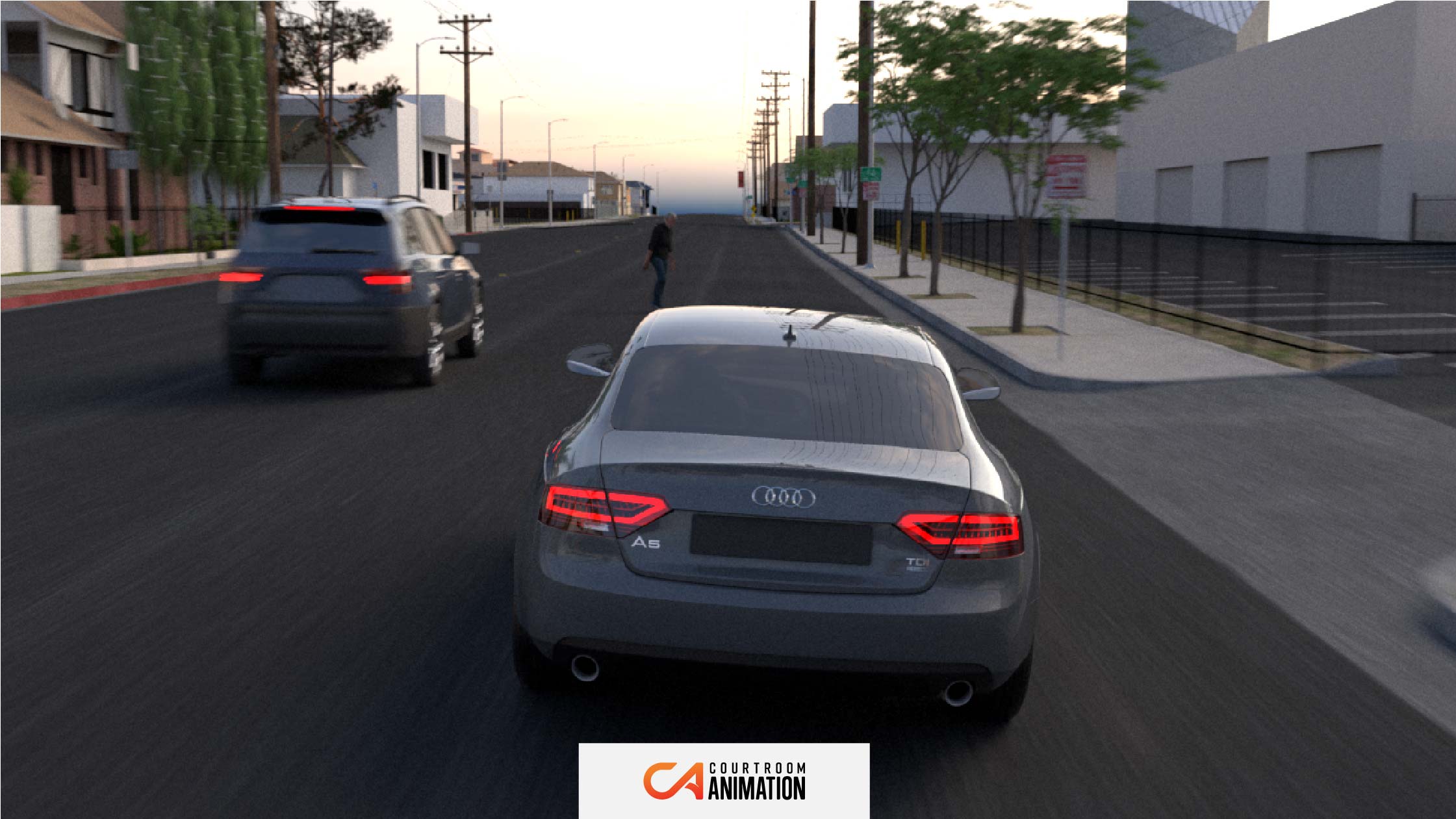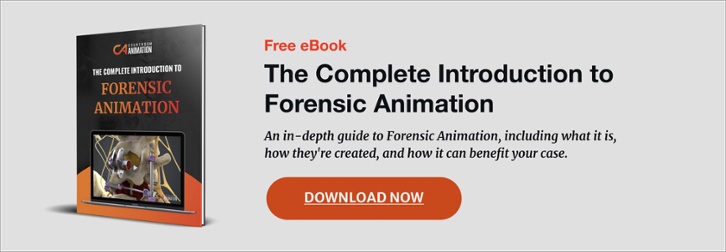
When information is presented with visual support, it has a higher chance of being retained than oral presentation alone. However, information’s retention rate is lowered when speaking of highly technical information.
In fact, throughout a 12-hour trial, a jury may only remember 10% of verbal testimony; however, that rate increases to 85% when the information is paired with a visual. That’s one of the reasons why the chances of landing a favorable verdict for your client improves if you pair facts with visual litigation aids.
But what type of visuals are the best fit for pairing with facts and data?
Demonstrative evidence uses data to visualize the perspective of your client, expert, or the incident in question. Demonstrative evidence includes any auditory or visual enhancements of real evidence. In contrast, real evidence is the objects or people tied directly to the events.
How do you introduce demonstrative evidence in your trial presentation for maximum effect? It is critical to present demonstrative exhibits at the right time, with the right audience, for the desired effect. Here is our guide on how to introduce your demonstrative evidence to the jury – starting with pre-trial focus groups and ending with your closing statement.
Example of Both Defense & Plaintiff Demonstrative Exhibits at Trial
Introduce Visuals in Pre Trial-Focus Group
Demonstrative evidence supports real evidence, and does not draw new conclusions. To be admitted, it must be reasonably similar to actual evidence. How do you find whether your demonstrative exhibit could sway the jury towards your desired verdict?
Introduce it to a pre-trial focus group.
You can judge how effective it will be on a jury by showing your legal animation or graphic to a focus group before trial. A pre-trial focus group presented with testimony supported by demonstrative evidence can help you decide:
- If any bias is present
- If it reasonably represents facts
- If the demonstrative exhibit lacks clarity
- How the evidence enhanced their understanding
Introducing the demonstrative evidence into your case early in the proceedings helps you understand its effectiveness, and gives you the opportunity to make any necessary changes.
Interested in what demonstrative evidence you can show the jury? Read one of our latest articles to see real trial demonstrative evidence examples.
Use Demonstrative Evidence in Opening Statements
Opening statements are highly influential in determining the jury’s initial opinion of your case. You set the tone for your side of the hearing and let the jury know what to expect.

During opening statements, you’ll want to grab the jury’s attention and give them something to remember. Use demonstrative evidence in your opening statement to:
- Educate the jury on the issue
- Describe the main points
- Explain themes that will be observed
An opening statement prepares the court for the evidence proceedings. When demonstrative evidence is presented during opening remarks, it helps establish a connection with jurors.
Enhance Expert Testimony with Visual Litigation Aids
It can be difficult for a jury composed of normal people to follow verbal explanations of subjects they’re not familiar with. If you have a case revolving around technical information that an expert witness will be testifying to, a demonstrative exhibit can increase its effect tenfold.
Discover if a demonstrative exhibit could fit into your client’s budget by downloading our free trial graphic pricing guide.
While trying to explain medical details or technical concepts in an accident, the jury might not understand solely verbal accounts. A trial animation, chart, or timeline can simplify the experts’ terminology and provide a visual guide.
- Demonstrative evidence supports expert testimony by:
- Allowing the jury to visually follow along
- Increasing the retention of expert testimony
- Simplify complicated verbiage and technical jargon
- Provide varying perspectives on the events that occurred
- Complex data and thorough reports are all for not without an easily digestible visual

Because demonstrative evidence is supportive evidence, having your expert testify to the accuracy of the video helps increase its admissibility. If your expert corroborates the evidence is a fair and accurate representation and helps explain the facts, it has more influence.
Feature Trial Animations in Closing Statements
When you need to highlight the high-level facts the jury needs to remember during your closing arguments, consider demonstrative evidence as an aid. You can recount the key takeaways and enforce the impact of your witness statements using visual enhancements.
Closing arguments are your last chance to reach the jury. Because visual information is stored for longer, a well-crafted demonstrative piece can stick in their minds during deliberation.
When one plaintiff attorney presented trial demonstratives, the jury awarded their client an $8 million verdict.
Demonstrative evidence has been applied to various high-profile cases with profound impact. Here are notable cases, both criminal and civil, that leveraged visual exhibits with success:
- Jacob Blake, 2020
- Depp v. Heard, 2022
- Kyle Rittenhouse, 2020
- Zimmerman v. Martin, 2012
Demonstrative evidence was explicitly used in closing arguments during the Zimmerman v. Martin trial. The trial animation reconstructed the position of struggle and corroborated witness testimony, leading to the jury rendering a not guilty verdict.
Introduce Your Demonstrative Exhibits Early
In order to be legally admissible, a visual has to be substantially similar to your case. It also may not take up undue time, and it cannot be misleading or too dramatized. Demonstrative evidence comes into a question of admissibility when it is more prejudicial than probative.

This indication means that the more people you show your evidence to, the more feedback you gain, and the better chance you have to make any necessary changes. Show your demonstrative evidence early in the litigation process and seek feedback.
Make changes where bias is shown. Keep things simple, accurately portray facts, and deliver them to:
- A Pretrial Focus Group
- Opposing Counsel
- Your Expert Witness
When deciding how to create your effective demonstrative animations, charts, or courtroom graphics, work with an experienced legal animation team. They will be able to make a powerful point without emotional prejudice.
How Will You Introduce Demonstrative Evidence?
In today’s technology-first world, gaining and keeping the jury’s attention is becoming more difficult. You need to be able to reach every juror and have them understand and remember your argument. Demonstrative evidence can help in this regard by providing visual aids to achieve this goal.
Knowing who to show your demonstrative evidence to and at what time during litigation will increase the admissibility rate and its impact on the jury. When used in opening and closing statements, your graphics will leave a lasting impression for the jury and opposing counsel. Pairing expert testimony with a profound visual graphic will help the jury present themselves in the situation.
So, how will you introduce demonstrative evidence in your next trial case?
To learn more about using demonstrative evidence in court, check out this in-depth guide for attorneys on forensic animation.
